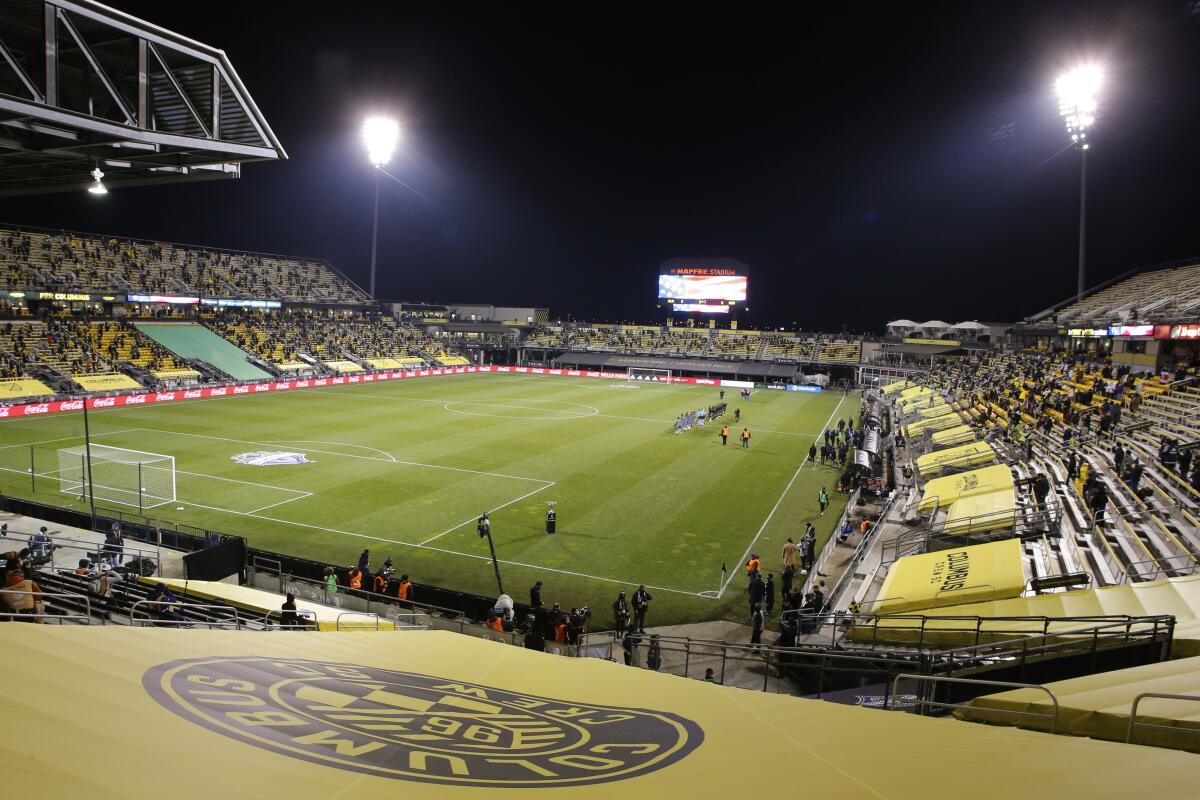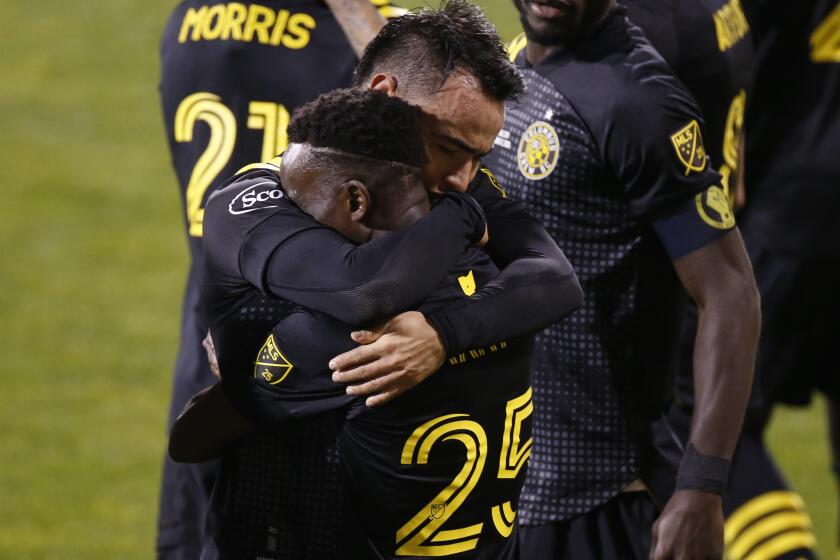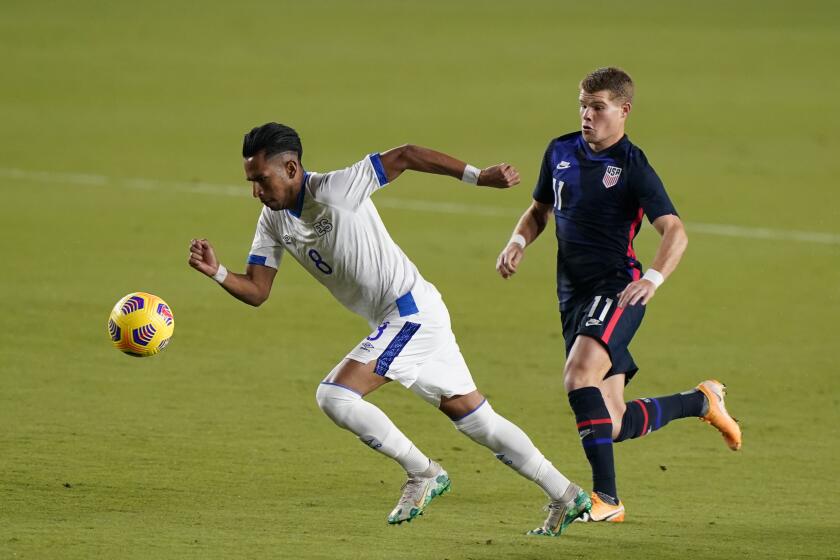News Analysis: Was it worth it to have an MLS season amid coronavirus?

- Share via
Each winter MLS commissioner Don Garber meets with reporters to sum up the state of the league. In normal times the address is an overly rosy mix of rainbows and butterflies.
These aren’t normal times. But the commissioner put a positive spin on the season just the same.
“We’re the only league in the world to play in a bubble and continue in our markets with a regular season and then complete a postseason in our local markets,” Garber said last week. “It was an outstanding, remarkable undertaking.”
He may have spiked the soccer ball a bit early though because two days later we learned the price tag for all those things when Bob Foose, executive director of the MLS players association, said nearly 20% of the league’s players were infected with the coronavirus at some point during the season. That’s more than four times the national rate.
And that certainly skewed the results on the field, affixing a big asterisk to just about everything that happened this season.
Consider that LAFC entered the postseason missing four starters — including Diego Rossi, the league’s leading scorer — due to the coronavirus while the Columbus Crew played Saturday’s MLS Cup final without midfielders Darlington Nagbe and Pedro Santos, who were in quarantine after becoming the ninth and 10th members of the team to contract the virus in the playoffs alone.
Lucas Zelarayan scores two goals to lift the Columbus Crew to a 3-0 victory over the Seattle Sounders and their first MLS Cup since 2008.
The Crew won anyway, with their 3-0 victory over the Seattle Sounders in the title match bringing the most challenging season in the league’s 25-year history to an end. But was it worth the cost?
Probably. Because for all the damage MLS endured this season, the cost of taking the year off could have been even greater.
Leaguewide, revenue dropped by nearly $1 billion in 2020, Garber said, forcing MLS to lay off nearly one in five employees. Many teams did the same and most of the workers who remained, including the commissioner, took pay cuts.
MLS relies on game-day income more than any other major U.S. sports league and because of COVID-19 precautions only a handful of teams were able to play before even a limited number of spectators after March. At the same time fewer fans watched from home, leading to a drop in regular-season TV ratings.
COVID also forced the league to shorten the schedule, from 34 to 23 geographically bunched regular-season games, the fewest in history. Nearly a third of the 26 teams didn’t play even that many after seven matches were canceled because of virus outbreaks.
Garber contributed to the wreckage by strong-arming the union into renegotiating its four-month-old collective-bargaining agreement before returning to play during the summer, forfeiting the hard-won good will he had built with the players. The two sides may be heading toward another showdown this winter if the league insists on starting the 2021 season in March.
“It’s just not enough time for guys to heal,” Foose said.
Starting the season then would require training camps to open in less than six weeks despite the fact four teams, including LAFC, are still playing in the CONCACAF Champions League. The final game of that tournament won’t be played until Dec. 22.
“There’s a significant amount of physical healing that has to happen,” Foose said. “I think we are dealing with an unprecedented level of emotional and mental healing that needs to happen as well.”
Yet for all the pain — physical, financial, emotional and otherwise — that went into finishing the truncated season, the fact MLS soldiered on leaves the league with a lot to celebrate.
After a four-month pause in play, the league sputtered back to life with the MLS Is Back tournament in Orlando, Fla., which got off to a rocky start with multiple infections forcing Nashville and Dallas out of the competition. But the rest of the league went forward, playing 51 games in 35 days in a quarantine bubble.
That the NBA, NWSL and WNBA all did their bubbles better doesn’t really detract from the MLS’ accomplishment.
COVID-19, however, wasn’t the only thing to shake the country in 2020. The Black Lives Matter movement forced a reckoning with systemic racism while a contentious election marked by allegations of voter fraud divided the nation.
So MLS followed the lead of Black Players for Change, a group of about 170 players, coaches and staff, and had teams take a knee before games to protest social injustice. It also supported election-related activities including voter-registration drives and the use of stadiums for voting.
And when U.S. Soccer disbanded its development academy at the start of the pandemic, MLS filled the void with its own program, enrolling more than 11,000 players and 113 academies or elite clubs.
Addressing racism, promoting democracy and helping save youth soccer would be laudable achievements under any circumstances. Doing it while nursing the league through a global pandemic that shot a $1-billion hole in its bottom line is even more impressive.
In their last game of the year, U.S. national soccer routs El Salvador 6-0.
The coming year may involve more sacrifice. Even with a vaccine on the way, infections and related deaths won’t cease any time soon and fans may not be allowed to fill stadiums again until late summer, squeezing the league’s economic lifeline again. Another showdown with the union, one that could be far more bruising, looms.
Yet Garber, as is his custom, remains optimistic
“I am very hopeful 2021 will be a way better year,” he said before adding, “I don’t think any business could sustain the kind of impact we sustained for two years in a row.”









